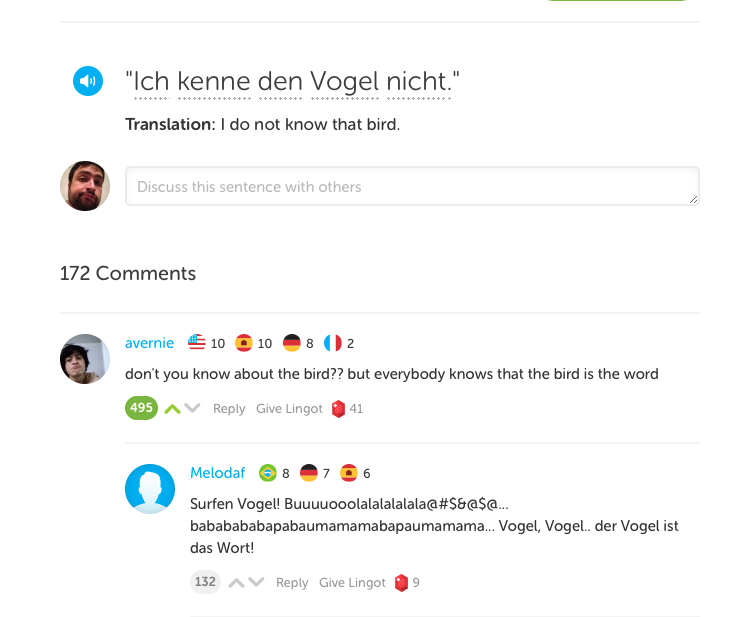A couple of days ago, on July 4th, I’ve reached a 1000 days streak on Duolingo. During this period, I’ve completed the entire trees for English, Spanish, German and Esperanto, as well as I’ve done some of the exercises in few other courses like Japanese, Irish, Norwegian, Klingon, and others.
I’d like to share how I did that, what I’ve learned during the process and if it was worth at all.
When it all started?
Back in 2013, Brazilians wouldn’t stop talking (and joking) about the World Cup and how the country wasn’t prepared to host such an event. I was one of them, and, at some point, I decided I didn’t want to be here during the games. I scheduled my Vacation to exactly the same period as the Cup would take place and New York was the chosen destination.
I’m a self-taught English speaker. Everything I know I learned from books, comics, movies and TV Shows. At the time, I had only had conversations in English twice, and my vocabulary was very limited. While planning the trip, I started getting concerned that my knowledge of the language wasn’t going to be enough. so I figured I would give Duolingo a chance.
I think I completed the course in about 2 months. In the end, as expected, I was nowhere near to being fluent on the language and I didn’t really learn a lot more than I already knew, but the simple fact that I managed to complete all the exercises without any major complications made me feel more confident about my language skills. The trip was great!

I went to a meet and greet with Christopher Lloyd in that trip. Isn't that awesome?
Even after finishing the course, I continued going back every day to make sure of keeping all the exercises gold! Yes, I fall too easily for these gamification tricks.
Later, I planned a trip to Argentina, so I decided to take the Spanish course. After that, I spent quite a long period studying German, and, when I realized I wasn’t making any more progress with German, I moved to Esperanto, which I’ve finally finished back in March (but I continue doing the exercises every day).
How did I do it?
First and foremost, I was only able to achieve this due to a few “Streak Freeze” usages (a power-up you can buy at their Shop and that will prevent you from losing your streak in case you can’t complete your daily goal) and paying for them to recover my lost streak in a couple of times where I missed the goal and didn’t have any “Streak Freeze” available to use. You might consider this as cheating and I won’t argue against that. What I can say in my defense is that I’ve only used the options offered by the site and that sometimes life happens and maybe you’ll not be able to even access the site.
Now for the how. If I could define the process in a single sentence, that would be: “Make a habit of it”. At first, I added daily reminders to make sure I wouldn’t miss a day. After some time, it was so ingrained in my daily routine that I didn’t even need the reminders anymore.
Probably the thing most people struggle with while making something a habit is to find time for that. For me, setting a low daily goal (20XP) helped a lot, as I was able to met it in just a couple of minutes in most of the cases. Sometimes, however, more than a few minutes were necessary to get the XP necessary to keep the streak (especially, during the German course), and in a few occasions I didn’t have that time available and if it wasn’t for the Streak Freeze, I would have missed the streak. After some time, whenever I knew I wouldn’t have too much time available, I developed the tactic of redoing the basic level exercises to quickly get the XP I need.
Still on the matter of time, using their website rather than the mobile app, also helped me complete the exercises faster, as I type way faster using the keyboard than the cellphone screen. And since we’re talking about typing, after some time I’ve learned a few tricks save even more time:
- Avoid unnecessary words in writing exercises. This varies from language to language, but one good example is to avoid pronouns in Portuguese, as this can be inferred from the verbs. For example, if the exercise was about translating “I drink coffee” to Portuguese, I would go for “Bebo café” instead of “Eu bebo café”.
- Avoid accents/signs (like tildes, cedilla, etc). Duolingo doesn’t care about them, so why should I? Depending on the words, it means a couple fewer keys pressed in each exercise. However, I’d only advise doing that if you’re sure you know how to use that in the “real world”.
- Go for shorter synonyms whenever possible. For example, I almost always write “kids” instead of “children” or “pretty” instead of “beautiful” and “handsome”. Again, only do this if you really know what is the best term to be used in a “real world” situation.
- Finally, if you really want to save some keystrokes, you can avoid spaces entirely. I accidentally learned that Duo doesn’t care about spaces and that “theduckreadsthenewspaper” is as valid an answer as “The duck reads the newspaper”
Was it any worth?
In a nutshell: Absolutely!.
I love learning new stuff so every chance I have to study something new is worth to me. In my opinion, Duolingo is a very interesting way to get your first contact with a language and quickly start learning something. However, it’s far from being a complete or perfect method and I believe that it can only an take you up to an intermediate level and that, only if you really dedicate yourself.
The chief learning method used by Duo is memorization. It will repeat the same words and sentences dozens of times until you know them by heart. This is a good thing if you’re new to the language, as it helps you quickly start building a vocabulary, but you will learn little or nothing about grammar. As a result, it’s likely that you’ll have memorized a bunch of sentences but you’re still not able to create your own. Even worse, most of the sentences you’ll learn are useless in a real-world situation (where would you use “She replaces the baby with a black dog”?). If you’re using the desktop website, the focus is still huge in memorization, but at least each level has a small grammar section with a few details about how the language works. However, if you’re using the mobile app, none of this is available. I highly recommend using the website as much as possible and resorting to the app only for practicing something you’ve already learned.

Wouldn't it be great to have a t-shirt with this sentence?
Another thing that is available only for the website users, is the discussion section. After answering a question, you’ll be able to discuss it with other users or see what has been discussed already. It is not uncommon that I don’t fully understand why my answer wasn’t accepted and I often end up finding an explanation for that in the discussion. There are some very supportive users in there, and a few times, they will leave some very detailed explanation. Way better than Duolingo’s. Some other times, you go there only for the fun:

The discussion section never disappoints me
As I said before, Duo reuses the same words again and again. As a result, you end up building a vocabulary that is not even close to an advanced level. You’ll definitely need to find other ways to improve on that.
Duolingo is also not great when it comes to speaking and pronunciation. The website simply doesn’t have any exercises for that and the exercises in the mobile app are useless, as they will sometimes fail even if you pronounced something correctly and will pass when you don’t.
With all that said, I still highly recommend using Duolingo as a tool to study languages. I think it’s great for a quick start and it’s helpful if you only have a few minutes available during the day and want to keep practicing at least a little bit. The number of courses on the site grows every year, which is great if you’re like me and are always open to trying something new. At the moment I’m studying Japanese in a more traditional method, but I still visit Duo every day to keep exercising what I’ve already learned there (and also to maintain my streak!).